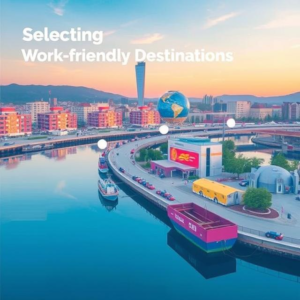How to Balance Work and Travel Effectively
Introduction
With remote work becoming more common, professionals are increasingly looking for ways to balance their careers while exploring new destinations. Whether you’re a freelancer, a digital nomad, or an employee with flexible work arrangements, maintaining productivity while traveling requires strategic planning and discipline.
This guide provides practical insights on how to effectively manage your workload, choose the right destinations, set up a mobile office, and maintain a healthy work-life balance while on the move.
The first step to successfully managing work while traveling is choosing the right approach based on your job requirements and lifestyle preferences.
a) Fully Remote Work
- Best suited for freelancers, entrepreneurs, and remote employees.
- Offers complete flexibility in choosing travel destinations.
- Requires self-discipline and strong organizational skills.
b) Hybrid Work (Partially Remote)
- Ideal for employees who can work remotely part-time while maintaining office responsibilities.
- Travel is limited to specific periods but allows for short workations.
- Requires clear communication with employers to ensure work commitments are met.
c) Short Workations (Temporary Remote Work)
- Best for professionals with occasional remote work privileges.
- Travel is planned around work commitments to avoid disruptions.
- Suitable for those who want to experience new places without committing to full-time travel.
Selecting the right work-travel model is essential for maintaining productivity and job stability while enjoying the benefits of travel.
2. Managing Time Effectively

Balancing work and travel requires strong time management skills to ensure professional responsibilities are met without compromising the travel experience.
a) Establish a Structured Work Schedule
- Define work hours based on your employer’s expectations and time zone differences.
- Communicate your availability with clients and colleagues to maintain workflow consistency.
b) Plan Tasks Around Time Zones
- Adjust work hours to align with your team’s schedule.
- Use time zone management tools like World Time Buddy for better coordination.
c) Utilize Productivity Tools
- Use task management apps such as Trello, Asana, or Notion to track work progress.
- Automate repetitive tasks with scheduling tools to free up more travel time.
d) Avoid Overloading Work on Travel Days
- Plan buffer days between work and travel transitions to avoid unnecessary stress.
- Batch tasks in advance to maintain workflow consistency while on the move.
Effective time management ensures that both work and travel experiences remain enjoyable and productive.
3. Selecting Work-Friendly Destinations

Not all destinations are equally suited for remote work. Choosing the right location can significantly impact productivity and work efficiency.
a) Cities with Strong Digital Infrastructure
For professionals who require stable internet and coworking spaces, consider:
- Bali, Indonesia – A hub for digital nomads with excellent coworking facilities.
- Lisbon, Portugal – Offers strong internet, affordability, and an international work-friendly community.
- Medellín, Colombia – Known for fast Wi-Fi, great weather, and a low cost of living.
- Chiang Mai, Thailand – A well-established remote work destination with a high quality of life.
b) Budget-Friendly Locations
For those seeking affordable destinations with a good work-life balance:
- Vietnam (Hanoi, Da Nang)
- Mexico (Playa del Carmen, Tulum)
- Georgia (Tbilisi)
- Eastern Europe (Budapest, Kraków)
c) Quiet Destinations for Deep Work
If solitude and focus are priorities, consider:
- Remote villages in Italy or France.
- Island retreats in Greece or the Philippines.
- Scenic mountain towns in Canada or Switzerland.
Selecting the right destination plays a key role in maintaining a sustainable work-travel lifestyle.
4. Setting Up an Efficient Mobile Office

A well-equipped workspace ensures uninterrupted workflow regardless of location.
a) Essential Equipment for Remote Work
- Lightweight Laptop – Ensures efficiency while traveling.
- Noise-Canceling Headphones – Helps maintain focus in public places.
- Portable Wi-Fi & Local SIM Card – Guarantees stable internet access.
- Power Bank & Universal Adapter – Essential for working from different locations.
b) Choosing Work-Friendly Accommodations
- Opt for hotels or Airbnb rentals with dedicated workspaces.
- Check Wi-Fi speed before booking accommodations using apps like Speedtest.
- Look for coworking spaces nearby for a more professional work environment.
A well-planned mobile office setup enhances productivity and minimizes work disruptions while traveling.
5. Maintaining Productivity While Traveling
Staying focused in a constantly changing environment requires effective strategies.
a) Implement Focus Techniques
- Pomodoro Technique – Work in short bursts (25-50 minutes) with brief breaks.
- Time Blocking – Assign specific hours for deep work and meetings.
b) Minimize Distractions
- Choose quiet workspaces away from tourist areas.
- Use browser extensions to block social media distractions during work hours.
c) Set Daily Work Goals
- Outline key tasks each day to maintain progress.
- Reward productivity with scheduled leisure activities.
With the right strategies, productivity can remain consistent despite changing locations.
6. Achieving Work-Life Balance While Traveling
Maintaining a balance between work and exploration is crucial for a fulfilling experience.
a) Set Boundaries Between Work and Leisure
- Avoid overworking by setting strict work hours.
- Disconnect from work after designated hours to fully enjoy travel experiences.
b) Plan Travel Activities Around Work Commitments
- Schedule sightseeing and leisure activities during non-work hours.
- Use weekends for longer excursions to avoid work disruptions.
c) Prioritize Self-Care
- Ensure adequate rest and downtime to prevent burnout.
- Engage in wellness activities such as yoga, meditation, or nature walks.
Maintaining work-life balance ensures long-term sustainability in a work-travel lifestyle.
7. Financial Planning for Work and Travel
Managing finances effectively is essential for a stress-free experience.
a) Budgeting and Expense Tracking
- Use finance apps like Mint or YNAB to track expenses.
- Choose cost-effective accommodations and transportation options.
b) Diversify Income Streams
- Consider freelancing, consulting, or passive income opportunities.
- Explore online courses, e-books, or affiliate marketing as additional revenue sources.
c) Prepare for Emergencies
- Invest in travel insurance for medical and financial security.
- Keep an emergency fund for unexpected situations.
Sound financial planning ensures long-term work and travel sustainability.
8. Overcoming Common Challenges
a) Dealing with Loneliness and Social Isolation
- Join coworking spaces and networking events.
- Connect with local communities and fellow travelers.
b) Staying Motivated While Working Remotely
- Set short-term and long-term work goals.
- Work from inspiring locations to stay engaged.
c) Navigating Cultural and Language Barriers
- Learn basic local phrases for smoother interactions.
- Use translation apps to bridge communication gaps.
Addressing these challenges proactively enhances the overall experience.
Conclusion
Balancing work and travel requires careful planning, time management, and adaptability. By selecting work-friendly destinations, setting up an efficient mobile office, managing finances wisely, and maintaining a structured routine, professionals can successfully integrate work with their passion for travel.
With the right strategies, it is possible to maintain productivity, explore the world, and enjoy a fulfilling work-life balance—proving that career growth and travel aspirations don’t have to be mutually exclusive.
More Post







Leave a Reply